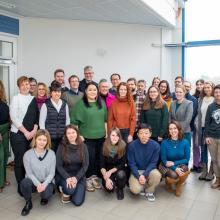Ashkenaz in New Environments
Actors, Practices and Spaces in Central European Jewish History during the Fifteenth and Sixteenth Centuries

Project Management: Universität Trier – Arye Maimon-Institut für Geschichte der Juden (AMIGJ)
Project Participants: Universität Trier, Mittelalterliche Geschichte · Universität Münster, Jüdische Studien · Universität Trier, Geschichtliche Landeskunde · Universität Duisburg-Essen, Salomon Ludwig Steinheim-Institut für deutsch-jüdische Geschichte
Sponsors: Deutsche Forschungsgemeinschaft (DFG)
Running time: -
Contact person (TCDH): Dr Joëlle Weis
Research Area: Software Systems and Research Infrastructure, Digital Literary and Cultural Studies
Keywords:
Website of the Project: Projektwebsite
The Research Group aims at a deeper understanding of the life-worlds of Ashkenazi Jews in the transition period between what is commonly called 'the Middle Ages' and 'the Early Modern era'. The roughly 200 years since the onset of widespread expulsion events around 1390 and down to the demographic stabilization of Jewish communities under the repressive conditions of confessional statehood saw fundamental social changes. They brought about massive challenges for the continuity of Jewish life in Central Europe.
This chapter in Jewish history is not yet well understood. Ist phenomenology is marked, first, by disruption, dislocation, and migration, but then also by the emergence of new life-worlds: more often than previously, Jews settled in places outside the medieval core regions of Jewish life in the German-speaking area (Hebr., ashkenaz); those who stayed more often lived outside the main towns and cities. The Jewish map of Central Europe as a whole underwent significant changes.
These shifts of settlement structure and cultural environments went hand in hand with changes in the political, legal, economic, linguistic, and religious conditions but also in religious, cultural, and daily practice. The changes occurred in social spaces of varying extent and structure and were strongly influenced by local and regional mobility as well as by long-distance migration. Understanding them requires more than a survey of the framework conditions; rather, it is indispensable to pay more attention to the Jewish agents involved, to their geographical movements over the course of time, to their personal relations and forms of self-organization. An adequate account of these processes therefore requires new methods of managing and combining the sources.
he Research Group will address this task in a combination of Judaic Studies approaches with those of other historical disciplines (Medieval History, Early Modern History, Comparative Regional History) and the Digital Humanities. The six individual projects of the first funding period will investigate, on the one hand, the Jewish settlement conditions in the German Empire and, on the other hand, the new settlements that emerged beyond, in Italy and Poland. Prosopographic research will highlight the ties between Jews in these Regions as well as their migration and communication. At the center of the scientific work program is a joint data management, which will result in the creation and development of the Index fontium historiae Judicae, an online resource for future researchers.
Subprojects of the First Phase (2025–2029):
- Subproject 1: Interaction and Organization: Ashkenazi Jews in Northern Italy During the 15th and Early 16th Centuries
(PI: Prof. Dr. Lukas Clemens, Trier University, Medieval History) - Subproject 2: Books, their Makers and Owners in an Age of Migration (Fifteenth to Sixteenth Centuries)
(PI: Prof. Dr. Katrin Kogman-Appel, University of Münster, Jewish Studies) - Subproject 3: Extra muros, intra muros – Access regulations towards Jews in the imperial and autonomous cities of the early modern period between norm and practice
(PI: Prof. Dr. Stephan Laux, Trier University, Comparative Regional History) - Subproject 4: Ashkenazi Jews in new urban life-worlds of Eastern Europe: the example of Greater Poland (1386–1434)
(PI: Dr. Jörg Müller, Trier University, Arye Maimon Institute for the History of the Jews) - Subproject 5: Continuity and Change in the Regional Organization of Jewish Life in the German Lands between the Middle Ages and the Early Modern Perio
(PI: Prof. Dr. Lucia Raspe, University of Duisburg-Essen, Salomon Ludwig Steinheim Institute for German-Jewish History) - Subproject 6: Data on Jewish individuals in the 15th and 16th centuries: computational modelling and analysis
(PI: Prof. Dr. Christof Schöch, Trier University, Trier Center for Digital Humanities; Dr. Christoph Cluse, Trier University, Arye Maimon Institute for the History of the Jews) - Coordination Project (Coordinator: Dr. Joëlle Weis, Trier University, Trier Center for Digital Humanities)
Related projects: Medieval Ashkenaz
Team TCDH
Dr Joëlle Weis
E-mail: weis uni-trier [dot] de
uni-trier [dot] de
Phone: +49 651 201-3017
Prof Dr Christof Schöch
E-mail: schoech uni-trier [dot] de
uni-trier [dot] de
Phone: +49 651 201-3264
Ruth Bruchertseifer
E-mail: bruchertsei uni-trier [dot] de
uni-trier [dot] de
Phone: 0651/201-3284
Viola C. Kämmer
E-mail: kaemmer uni-trier [dot] de
uni-trier [dot] de
Phone: +49 651 201-1295








